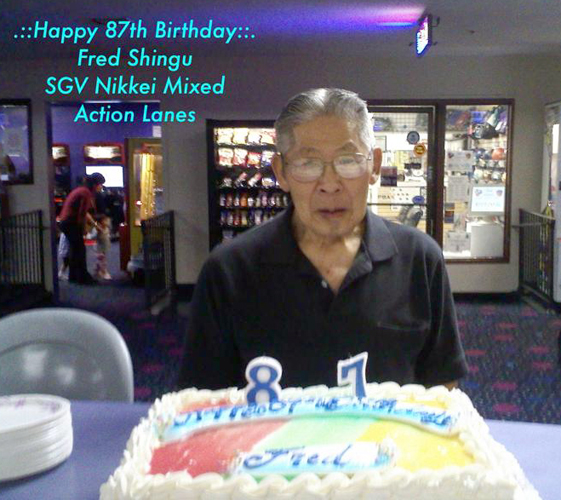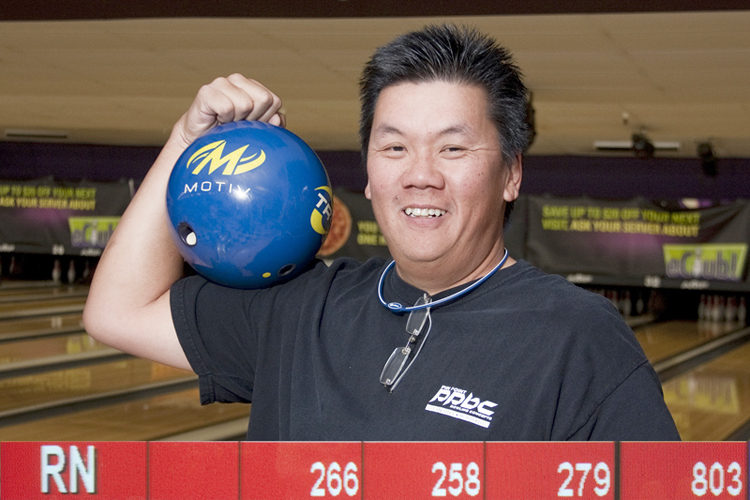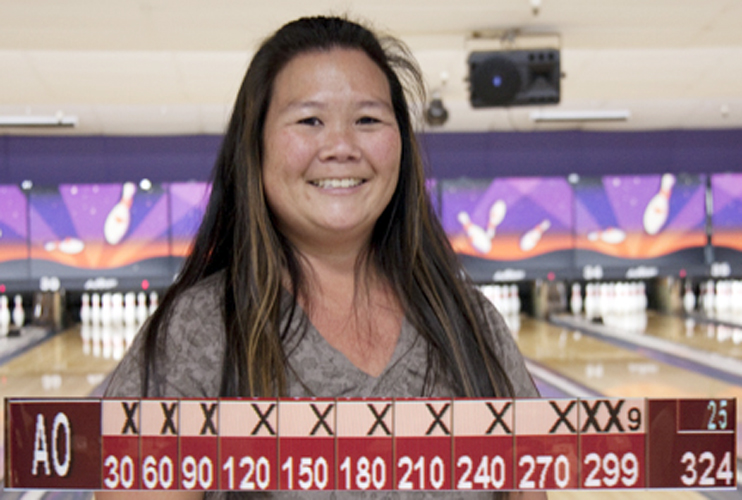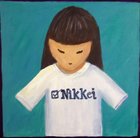Category Archives: BLOG
Romeo Natividad Shoots 803
Alyson Orosco Shoots 299
ICE BOWLING A HIT IN TOKYO
David Tomita Shoots 300 at AMF Beverly
June 11, 2009 in the Yuk Hino Bowling League
Cell Pearl was drilled by Roger at PPBC 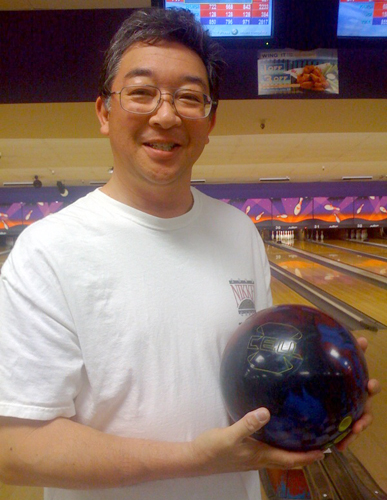
Jim Cale Passes Away on July 11, 2008
CONDOLENSES… Jim Cale passed away on July 11. He had been hospitalized for a month and a half due to a failing liver condition. There was no funeral service per Jim’s request but there may be a possible Memorial tournament hosted by AMF El Dorado Lanes in the fall on behalf of his honor. Jim was the pro shop owner inside AMF El Dorado Lanes.
A Yonsei’s Reflections… on returning to my JA bowling roots
Today, basketball and golf are the sports of choice in Japanese American communities, at least it seems to be in Southern California. However, back in the 1950s, ‘60s, and ‘70s, JA bowling leagues were all the rage. In it’s heyday, you almost had to be on a waiting list to join a team. Leagues were often scheduled back-to-back on the same night.
As part of the More Than a Game exhibition, a media piece was created called Top of Their Game in which top JA athletes were interviewed. One of the segments was with Dusty Mizunoue and Judy Kikuta, filmed at Holiday Bowl during their Nisei women’s bowlin
In 2000, the Japanese American National Museum had an exhibition called More Than a Game: Sport in the Japanese American Community. Included in the exhibition was a section about Japanese American bowlers like Dusty Mizunoue and Judy (Seki) Kikuta, the first woman west of the Rockies to bowl a perfect 300 game. I learned that it was a Nisei team in Seattle who first challenged the American Bowling Congress policy prohibiting membership by people of color by entering a Boeing Bowling League in 1949. By 1950, following a string of lawsuits and other challenges to the ban, the color ban in bowling was finally lifted.
Although bowling leagues became integrated, Nisei or JA bowling leagues still flourished. Hundreds of Nisei bowling teams and many leagues were formed. The JACL and others organized bowling tournaments. My parents and many other relatives on both sides of my family have participated.
Growing up, I spent a lot of my Friday nights at Holiday Bowl in the Crenshaw district of Los Angeles. My parents bowled along with several of my aunts and uncles in a Nisei league there from 9pm until whenever they finished. By the time we actually finally left the alley, it was usually well past 12pm.
I remember their bowling shirts back then had the “Go For Broke” insignia on the sleeves. Later, that league moved to Little Tokyo, but my parents remained at Holiday Bowl with the new JA league that started with others who didn’t make the move over.
As a young child, my sister and I would bring our Strawberry Shortcake dolls and play with our cousins whose parents also bowled in the league. We didn’t really watch the action on the lanes. It was mostly a time for our own play. By the end of the evening, we would lay down on the hard, plastic continuous row of benches that extended behind the lanes and wait for our parents to finish their games.
As we got a little older, we brought money to play video games. We would carefully ration them out so that we would still be able to play late in the night. Occasionally, it was also a place for us to sell our fundraising candies. Grace’s chocolate Easter eggs, chocolate bars, etc. We were painfully shy back then, but managed to muster up the courage walk down the alley selling our “wares”.
Sometimes, we would go to the coffee shop for a late-night snack. We always ate dinner before-hand, but we would go there for French fries or sometimes jello and hang out at a table for hours and catch up with our cousin as she told us about her latest crush.
Although I did very little actual bowling at Holiday Bowl, I still have many fond memories of my time there. Maybe that’s why despite the fact that I’ve hardly put my bowling ball and shoes to use in the last ten years, when a coworker asked if I would join his Nisei bowling league team, I jumped at the chance. Well, maybe not jumped…more like gently prodded and bribed with food.
For me, it’s partly for light exercise, but mostly for fun and the sense of camaraderie that seems unique to bowling. What other sport do you give high-fives and encouraging slaps whether the outcome is good or bad? It’s a very supportive atmosphere…you cheer the strikes, spares, and tricky splits, and give commiserating groans for the missed pins and opportunities.
Then there are the side pots. Yes, gambling goes hand-in-hand with bowling. In fact, there are many Nisei mini-tournaments held in Las Vegas—very popular as an excuse to go to Vegas, but at least they have an additional opportunity to win some gambling money. My parents go several times a year. They still bowl regularly—every Tuesday morning, and my mother recently also started a Friday morning league.
Apparently, it is not uncommon for these Nisei and Sansei to bowl in multiple leagues, sometimes even in different bowling alleys. Men and women in their sixties, seventies, eighties, and some even in their nineties. In my parents’ league, my father is still considered young in his mid-seventies. Most of them, like my parents, have bowled for a long time.
In my new league, there are some younger people like me (and by younger, I mean in their thirties and forties), but most of them are older. I wonder about the future of these JA bowling leagues. There still seems to be quite a few of them around in Southern California, but because they rely on the same people, as they are no longer able to bowl, will the leagues die out? There doesn’t seem to be enough younger people coming in. How can these leagues survive? Once you start losing people, it seems like it’ll start shrinking exponentially.
To learn about Holiday Bowl, visit the online Holiday Bowl History Projectfor a timeline, essay, resources, and a database of video interviews.
Holiday Bowl is now gone. Many other alleys have closed over the past ten years. As we lose these and other significant sites of our Nikkei communities, will we also lose that sense of community…or does it just change? Instead of bowling alleys, maybe it’s golf courses and basketball courts that become the place that we connect.
*Historical information used in this article came from More Than a Game: Sport in the Japanese American Community edited by Brian Niiya, published by the Japanese American National Museum in 2000 as a companion to the exhibition of the same name.
© 2007 Vicky Murakami-Tsuda
Rokuro “Fuzzy” Shimada, 85, legendary bowler dies
3/6/07
http://origin1.mercurynews.
Rokuro “Fuzzy” Shimada, the first Asian-American to roll a 300 game in organized play, bowled five perfect games during his professional career.
Actually, Mr. Shimada had six 300s, counting his first at San Carlos
Bowl. But because the American Bowling Congress was a “white men only” association in 1949, the feat was ignored by official record-keepers.
“I held no animosity against the ABC at the time,” Mr. Shimada said
during an interview in the late 1990s. “That was their rule, and I had
to abide by it.”
So Mr. Shimada and other locals organized their own league, the San
Jose Nisei Bowling Association. When ABC’s restrictions were finally lifted in 1953, the Japanese-American was at liberty, finally, to take on top-ranked players.
Continue reading Rokuro “Fuzzy” Shimada, 85, legendary bowler dies
85-year-old Nisei bowler is in league of her own
If you’ve been searching for the secret to good looks and longevity, put away the oat bran and the Oil of Olay. There’s no need to look further than Lane No. 11 at the Ritz Classic bowling alley, where Grace Tasaka is going for three strikes in a row.
As she rolls out another of her wicked curve balls, Grace doesn’t look more than 50 years old, 55 tops. Ritz bowlers are shocked to learn that she’s been old enough to order from the senior citizens menu for 30 years. She’s 85 — about the same number as my bowling average, which shows that I could certainly learn a thing or two from a pro like Grace.Plenty of other people have, especially the 83 seniors who bowl in the all-Japanese Nisei League that Grace started 11 years ago at the Ritz. Nisei is Japanese for “second generation,” meaning that if you’re a third- or fourth-generation bowler, you’re out of luck.
Only those 55 and older with a Japanese heritage are allowed to bowl in the Nisei league. Although that put me out on both counts, Grace still wanted me to join her and her bowling team — the Mini Four — for a Free Lunch of burgers and fries at the Ritz on a recent Wednesday.
As pins clattered loudly around us, Grace explained how she came up with the idea for an all-Japanese bowling league.
“I was bowling with another couple and we were talking about how it would be fun to get some other Japanese seniors to join us,” she says. “A lot of second-generation Japanese were retiring, and I thought this might be a good way for them to stay active and get out of the house.”
“At first, I was a little worried about discrimination — I didn’t want people to feel excluded,” she admits. “But then we decided it would really be no different than an all-Shriners league, or an all-Catholics league. The main thing was getting some of the older Japanese people together once a week to share stories and bowl.”
Like many Nisei league bowlers, Grace has tales to tell of hard times and dashed hopes. She knows what it is like to lose everything. During World War II, when she and her family were living in Berkeley, Calif., the U.S. government ordered them and thousands of other coastal Japanese-Americans to report to internment camps.
Grace ended up at the Topaz camp in Utah’s west desert. So did another Nisei bowler, Ted Nagata, a retired graphics artist who designed the clever skyline-mountains logo for the Salt Lake City Olympic Bid Committee.
Watching them high-five their team members after each strike, it is unfathomable to think that their own government once thought of them as spies. “Yes, it was difficult,” says Grace, “but I have no bad feelings about it today. You have to move on.”
And so today you’ll find her every Wednesday at the Ritz, cheering the Mini Four to score strikes and pick up splits so they can contend for first place with the Miso Super and Four of a Kind. “If I’m still bowling when I’m Grace’s age, I’ll be happy,” says teammate Joe Sueoka, 68, a retired accountant. “She gives us all hope.”
Joe always cheers when the opposing team gets a strike, as do Grace and her other teammates, Mabel Okubo and Shig Nagata, both 75. “We all support each other, even when we’re losing,” says Grace, who hopes to bowl well into her 90s.
That shouldn’t be a problem, especially since Grace Tasaka isn’t even the oldest person in the league. That honor belongs to Nick Tasaka, 86, who is hoping to knock his wife’s team out of third place with two strikes in a row in Lane No. 5.
Have a story? Let’s do lunch. E-mail your name, phone number and what’s on your mind to [email protected] or send a fax to 466-2851. You can also write me at the Deseret News, P.O. Box 1257, Salt Lake City, UT 84110.
The Original 101 Ways to Tell If You’re Japanese American
by Jenni Emiko Kuida and Tony Osumi
Inspired by similar Chinese and Pilipino lists, we took a shot at creating one for Japanese Americans. Written from a Southern California Sansei and Yonsei perspective, we tried to include not only Issei, Nisei and older Sansei insights, but those from later post-WWII Shin Issei and Nisei. But creating an all inclusive list is impossible, so we see this as a work in progress and courage others to add to the list. There’s no reason why this can’t be a 1001 list, neh?
Although written in good fun, understanding what it means to be JA helps define who we are as a community and the issues we face. More importantly, as we further study Japanese/Asian American history, we might begin to see current issues like immigrant-bashing, attacks on civil rights/affirmative action and the growing concentration of wealth and resources upward to a select few, in new ways.
Yes, Buddhaheads, there is life after Redress.
We would like to thank all those who shared their suggestions and helped make this list possible.
1.You know that Camp doesn’t mean a cabin in the woods.
2.The men in your family were gardeners, farmers or produce workers. Continue reading The Original 101 Ways to Tell If You’re Japanese American

